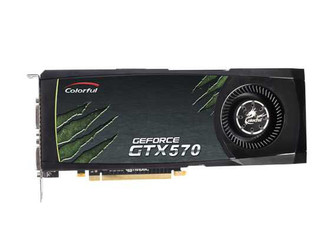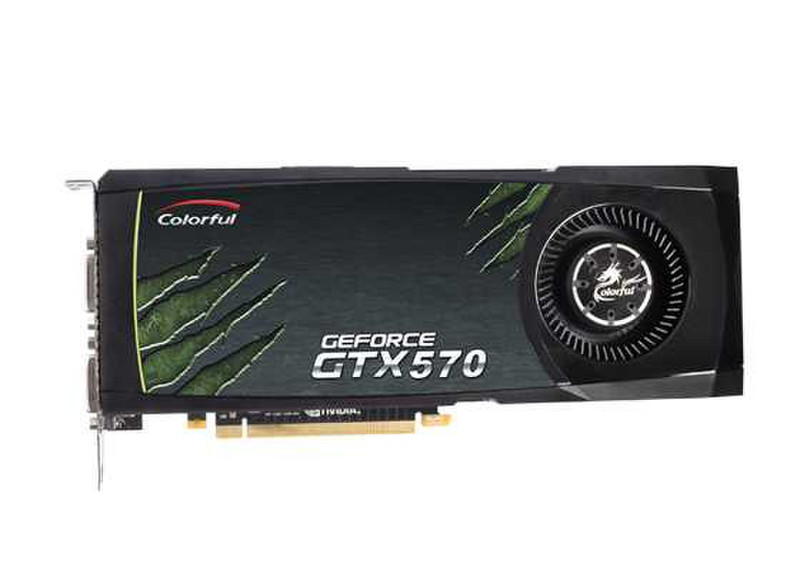Catalog
-
Catalog
- Antiquitäten & Kunst
- Auto & Motorrad: Fahrzeuge
- Baby
- Business & Industry
- Bücher
- Camping & Outdoor
- Feinschmecker
- Garden & patio
- Haustierbedarf
- Heimwerken & Garten
- HiFi & Audio
- Home, Construction, Renovation
- Household appliances
- Kleidung & Accessoires
- Modellbau
- Musik
- PC- & Videospiele
- Photo & camcorders
- Sammeln & Seltenes
- Spielzeug
- TV, Video, DVD
- Telekommunikation
- Uhren & Schmuck
- Wellness & Beauty
- computers & electronics
- entertainment & hobby
- fashion & lifestyle
- food, beverages & tobacco
- health & beauty
- institutional food services equipment
- medical equipment, accessories & supplies
- office
- sports & recreation
- vehicles & accessories
- weapons & ammunition
Filters
Search

Colorful N570-125-C01 GeForce GTX 570 1.25GB GDDR5 graphics card
🚚 Select the country of delivery:
Delivery from:
Germany
Sale and delivery by:
Where to buy and prices (Advertising *)
On Top
Technical specifications
On Top
Performance
| DirectX version | 11 |
|---|---|
| Shader model version | 5.0 |
| TV tuner integrated | N |
| PhysX | Y |
| NVIDIA 3D Vision | Y |
Ports & interfaces
| Interface type | PCI Express 2.0 |
|---|---|
| Mini HDMI ports quantity | 1 |
Memory
| Discrete graphics adapter memory | 1.25 GB |
|---|---|
| Graphics adapter memory type | GDDR5 |
| Memory bus | 320 bit |
| Memory clock speed | 3800 MHz |
Processor
| Graphics processor family | NVIDIA |
|---|---|
| Maximum analog resolution | 2048 x 1536 pixels |
| Processor frequency | 732 MHz |
| Shader clock | 1464 MHz |
| Stream processors | 480 |
| Maximum digital resolution | 2560 x 1600 pixels |
| CUDA | Y |
Design
| Cooling type | Active |
|---|
Other features
| HDMI | Y |
|---|
Additionally
| Dual-link DVI | Y |
|---|---|
| Graphics controller | GeForce GTX 570 |
NVIDIA GeForce GTX 570, 1280 MB, GDDR5, 732 MHz, 320 bit, DirectX 11, OpenGL 4.1, PCI Express 2.0
<b>Colorful570-1280M D5 CH (N570-125-C01)</b>
<b>CUDA</b>
NVIDIA® CUDA™ is a general purpose parallel computing architecture that leverages the parallel compute engine in NVIDIA graphics processing units (GPUs) to solve many complex computational problems in a fraction of the time required on a CPU. It includes the CUDA Instruction Set Architecture (ISA) and the parallel compute engine in the GPU.
<b>PhysX</b>
NVIDIA® PhysX® technology delivers real-time, hyper-realistic physical and environmental gaming effects in the games you want to play today and tomorrow. “Canned” reactions are a thing of the past – PhysX-powered games comes to life with blazing explosions, reactive debris, realistic water, and lifelike character motion.
<b>SLI</b>
NVIDIA SLI technology allows you to intelligently scale graphics performance by combining multiple NVIDIA graphics solutions in a single system with an NVIDIA nForce SLI media and communications processor.This technology delivers up to twice the performance of a single graphics solution.
<b>3D Surround</b>
NVIDIA 3D Surround or NVIDIA 3D Vision Surround technology helps to expand 3D gaming across three 1080p displays, and with the SLI configuration it can deliver the graphics horsepower to drive 750M pixels/second for screen 3 times Full HD 1080p 3D Vision gaming for an incredible 5760x1080 experience.
<b>PureVideo</b>
NVIDIA PureVideo technology is the combination of a dedicated video processing core and software that delivers ultra-smooth, high-definition H.264, WMV, and MPEG-2 movies with minimal CPU utilization and low power consumption. And the high-precision subpixel processing enables videos to be scaled to any size.
<b>GDDR5</b>
GDDR5 (Graphics Double Data Rate, version 5) SGRAM is a type of high performance dynamic random- access graphics card memory designed for applications requiring high bandwidth. It is based on DDR3 memory which has double the data lines compared to DDR2 but GDDR5 also has 8 bit wide prefetch buffers like GDDR4.
<b>1280MB</b>
Video memory is used to hold the information necessary for a graphics card to drive a display device. In modern 3D graphics cards, the video memory may also hold 3D vector data, textures, backbuffers, overlays and GPU programs.For high end graphics cards, 1G to 2G or even more video memory is necessary to delivers all its performance power. For mid-range cards, 512M to 1G is usually enough, while for the entry level cards 256M or less is generally enough for the card performance.
<b>Mini HDMI</b>
A Mini HDMI connector, or Type C of HDMI is defined in the HDMI 1.3 specification , and is intended for portable devices. It is smaller than the normal HDMI (Type A) plug connector (10.42 mm × 2.42 mm) but has the same 1pin configuration.
<b>PCI-E 2.0</b>
PCI Express (Peripheral Component Interconnect Express), officially abbreviated as PCIe or PCI-E, is a computer expansion card standard designed to replace the older PCI, PCI-X, and AGP standards. PCI Express 2.0 specification was released in 2007 and doubled the rate of PCI-E 1.0 to a data rate of 500 MB/s and a transfer rate of 5.0 GT/s.
<b>OpenGL</b>
OpenGL (Open Graphics Library) is the computer industry's standard application program interface (API) for defining 2-D and 3-D graphic images.
<b>CUDA</b>
NVIDIA® CUDA™ is a general purpose parallel computing architecture that leverages the parallel compute engine in NVIDIA graphics processing units (GPUs) to solve many complex computational problems in a fraction of the time required on a CPU. It includes the CUDA Instruction Set Architecture (ISA) and the parallel compute engine in the GPU.
<b>PhysX</b>
NVIDIA® PhysX® technology delivers real-time, hyper-realistic physical and environmental gaming effects in the games you want to play today and tomorrow. “Canned” reactions are a thing of the past – PhysX-powered games comes to life with blazing explosions, reactive debris, realistic water, and lifelike character motion.
<b>SLI</b>
NVIDIA SLI technology allows you to intelligently scale graphics performance by combining multiple NVIDIA graphics solutions in a single system with an NVIDIA nForce SLI media and communications processor.This technology delivers up to twice the performance of a single graphics solution.
<b>3D Surround</b>
NVIDIA 3D Surround or NVIDIA 3D Vision Surround technology helps to expand 3D gaming across three 1080p displays, and with the SLI configuration it can deliver the graphics horsepower to drive 750M pixels/second for screen 3 times Full HD 1080p 3D Vision gaming for an incredible 5760x1080 experience.
<b>PureVideo</b>
NVIDIA PureVideo technology is the combination of a dedicated video processing core and software that delivers ultra-smooth, high-definition H.264, WMV, and MPEG-2 movies with minimal CPU utilization and low power consumption. And the high-precision subpixel processing enables videos to be scaled to any size.
<b>GDDR5</b>
GDDR5 (Graphics Double Data Rate, version 5) SGRAM is a type of high performance dynamic random- access graphics card memory designed for applications requiring high bandwidth. It is based on DDR3 memory which has double the data lines compared to DDR2 but GDDR5 also has 8 bit wide prefetch buffers like GDDR4.
<b>1280MB</b>
Video memory is used to hold the information necessary for a graphics card to drive a display device. In modern 3D graphics cards, the video memory may also hold 3D vector data, textures, backbuffers, overlays and GPU programs.For high end graphics cards, 1G to 2G or even more video memory is necessary to delivers all its performance power. For mid-range cards, 512M to 1G is usually enough, while for the entry level cards 256M or less is generally enough for the card performance.
<b>Mini HDMI</b>
A Mini HDMI connector, or Type C of HDMI is defined in the HDMI 1.3 specification , and is intended for portable devices. It is smaller than the normal HDMI (Type A) plug connector (10.42 mm × 2.42 mm) but has the same 1pin configuration.
<b>PCI-E 2.0</b>
PCI Express (Peripheral Component Interconnect Express), officially abbreviated as PCIe or PCI-E, is a computer expansion card standard designed to replace the older PCI, PCI-X, and AGP standards. PCI Express 2.0 specification was released in 2007 and doubled the rate of PCI-E 1.0 to a data rate of 500 MB/s and a transfer rate of 5.0 GT/s.
<b>OpenGL</b>
OpenGL (Open Graphics Library) is the computer industry's standard application program interface (API) for defining 2-D and 3-D graphic images.
-
Payment Methods
We accept:















